
Earl of Halsbury, in the County of Devon, was a title in the Peerage of the United Kingdom. Halsbury is a historic manor in the parish of Parkham, near Bideford, Devon, long the seat of the Giffard family and sold by them in the 18th. century. The title was created on 19 January 1898 for the lawyer and Conservative politician Hardinge Giffard, 1st Baron Halsbury, and son of Stanley Lees Giffard, the first editor of the Evening Standard newspaper. Hardinge Giffard was Lord High Chancellor of Great Britain from 1885 to 1886, 1886 to 1892 and 1895 to 1905, and had already been created Baron Halsbury, of Halsbury in the County of Devon, on 26 June 1885, and was made Viscount Tiverton, of nearby Tiverton, at the same time he was given the earldom. Those titles were also in the Peerage of the United Kingdom. He was descended from the family of Giffard of Brightley, Chittlehampton, a junior line of Gifford of Halsbury. A younger son of the first of the Brightley family was Roger Giffard (d.1603) who purchased Tiverton Castle which he made his home. The 1st Earl in fact had no close connection with Halsbury, as the closest of his ancestors born there was Sir Roger Giffard of Brightley (d.1547) and even less with Tiverton, the home of none of his ancestors but only of a very distant cousin, but nevertheless chose these places as his titles.

South Tawton is a village, parish and former manor on the north edge of Dartmoor, Devon, England. An electoral ward bearing the same name exists. At the 2011 census the population was 1,683.
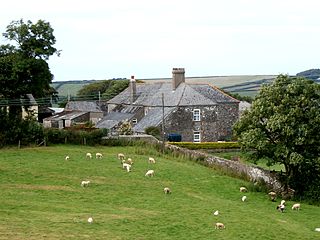
Halsbury is a historic manor in the parish of Parkham in North Devon, England. It is situated 2 miles north-east of the village of Parkham and 4 miles south-west of the town of Bideford. Halsbury was long a seat of the ancient Giffard family, a distant descendant of which was the celebrated lawyer Hardinge Stanley Giffard, 1st Earl of Halsbury (1823–1921), who adopted the name Halsbury for his earldom and was the author of the essential legal reference books Halsbury's Statutes. Halsbury Barton, now a farmhouse, retains 16th- and 17th-century elements of the former manor house of the Giffard family. It was described in a record of 1560 as a "new dwelling house".
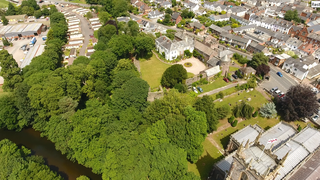
Tiverton Castle is the remains of a medieval castle dismantled after the Civil War and thereafter converted in the 17th century into a country house. It occupies a defensive position above the banks of the River Exe at Tiverton in Devon.

Tapeley is a historic estate in the parish of Westleigh in North Devon, England.

Weare Giffard is a small village, civil parish and former manor in the Torridge district, in north Devon. The church and manor house are situated 2 1/2 miles NW of Great Torrington in Devon. Most of the houses within the parish are situated some 1/2-mile east of the church. The church is situated on a hillside to the north and slightly above the wide and flat valley floor of the River Torridge. The Church of the Holy Trinity and the adjacent Weare Giffard Hall are designated members of the Grade I listed buildings in Devon.

Holcombe Rogus is a historic manor in the parish of Holcombe Rogus in Devon, England. The present grade I listed Tudor manor house known as Holcombe Court was built by Sir Roger Bluett c.1540 and was owned by the Bluett family until 1858 when the estate was sold to Rev. William Rayer. The house is immediately to the west of the parish church. The gardens and grounds are screened off from the public road at the south by a high wall in which is a tall and broad entrance archway which forms the start of the entrance drive.

Colonel John Giffard (1602–1665), of Brightley in the parish of Chittlehampton, Devon, England, was a Royalist leader during the Civil War. Giffard commanded the Devon Pikemen at the Battle of Lansdowne in 1643, in which his 3rd cousin the Royalist commander of the Cornish forces Sir Bevil Grenville (1596-1643) was killed in heroic circumstances. Giffard's loyalty to the Royalist cause led to him being proposed in 1660 as a knight of the intended Order of the Royal Oak. He was personally known to the biographer John Prince (1643–1723) who included him as one of his Worthies of Devon. He was buried in Chittlehampton Church, where his small kneeling effigy survives on the base of the monument he erected in 1625 to his grandfather.

Annery was an historic estate in the parish of Monkleigh, North Devon.
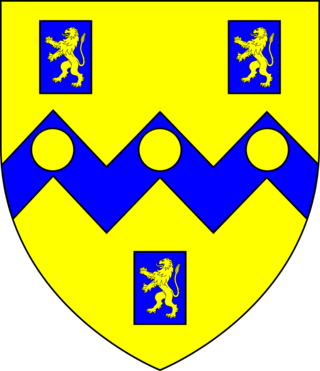
John Rolle (1522–1570) of Stevenstone, in the parish of St Giles in the Wood, near Great Torrington, Devon, was the eldest son and heir of George Rolle, MP, founder of the great Rolle family of Stevenstone, by his second wife Eleanor Dacres. Three monuments survive in memory of his immediate family in the churches of St Giles in the Wood and Chittlehampton.

The feudal barony of Bampton was one of eight feudal baronies in Devonshire which existed during the mediaeval era, and had its caput at Bampton Castle within the manor of Bampton.
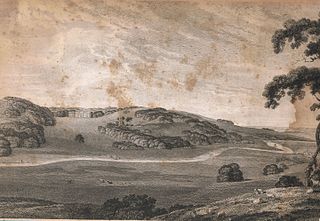
The historic manor of Tawstock was situated in North Devon, in the hundred of Fremington, 2 miles south of Barnstaple, England. According to Pole the feudal baron of Barnstaple Henry de Tracy made Tawstock his seat, apparently having abandoned Barnstaple Castle as the chief residence of the barony. Many of the historic lords of the manor are commemorated by monuments in St Peter's Church, the parish church of Tawstock which in the opinion of Pevsner contains "the best collection in the county apart from those in the cathedral", and in the opinion of Hoskins "contains the finest collection of monuments in Devon and one of the most notable in England".
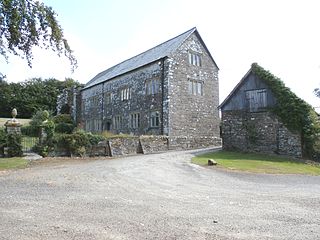
Bremridge is a historic estate within the former hundred of South Molton in Devon, England. It is now within the parish of Filleigh but was formerly in that of South Molton. It is situated 8 miles north-west of South Molton. Since the construction of the nearby A361 North Devon Link Road direct access has been cut off from Bremridge to Filleigh and South Molton. The surviving wing of the mansion house built in 1654 is a Grade II* listed building. Bremridge Wood is the site of an Iron Age enclosure or hill fort, the earthwork of which is situated on a hillside forming a promontory above the River Bray. In Bremridge Wood survives a disused tunnel of the former Great Western Railway line between South Molton and Barnstaple, much of the course of which has been used for the A361. The tunnel is 319 yards long and was identified as "Bremridge Tunnel" in the 1889 Ordnance Survey map but as "Castle Hill Tunnel" in subsequent editions.

Margaret II Audley was a co-heiress to the feudal barony of Barnstaple in Devon, England.

Yeo Vale is an historic estate in the parish of Alwington in North Devon, England. The grade II listed mansion house known as Yeo Vale House, situated 1 mile east of Alwington Church and 3 miles south-west of Bideford, incorporating a 15th-century gatehouse, was demolished in 1973, having been abandoned as a residence in 1938 and having fallen into a dilapidated state. it was situated in the valley of the River Yeo, a small river flowing into the River Torridge immediately above Bideford. The barton or farmhouse survives, to which was attached the mansion house, together with various out-buildings and stone walls. A private mediaeval chapel was formerly attached to the mansion house and in the early 18th century was demolished and rebuilt as a folly on a hill about 1/4 mile south of the mansion house. It survives today as a ruin overgrown with trees and ivy.

Sir Simon Leach (1567–1638) of the parish of All Hallows, Goldsmith Street, Exeter and of Cadeleigh, Devon, was Sheriff of Devon in 1624. His surviving monument in St Bartholomew's Church, Cadeleigh is the largest of its type in any Devon parish church.
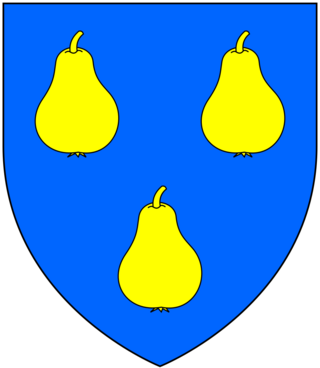
Sir Hugh Stucley (1496–1559) was the lord of Affeton in Devon, and Sheriff of Devon in 1545. His third son was Thomas Stukley, known as "The Lusty Stucley".

North Wyke is an historic manor in the parish of South Tawton, Devon. The surviving grade I listed manor house, the original Devonshire seat of the Wyke family from the early 13th century to 1714, retains its basic mediaeval form, but was "improved and reconstructed" by Rev. William Wykes-Finch (d.1920) in 1904, historian and descendant of the Wyke family, to the design of G.H. Fellowes Prynne. Currently, the manor is part of Rothamsted Research's North Wyke site.
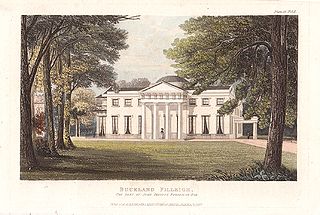
The manor of Buckland Filleigh was a manor in the parish of Buckland Filleigh in North Devon, England. Mentioned in the Domesday Book, the manor and its estates passed through several families, including over 300 years owned by the Fortescues.

Ernsborough is an historic Saxon estate dating from the 9th or 11th century, situated in the parish of Swimbridge in Devon, England, about 2 miles south-east of the village of Swimbridge. It is best remembered today for having contained during the 14th century a high-status mansion house occupied by the Mules or De Moels family, closely related to Baron Moels of Somerset.




























